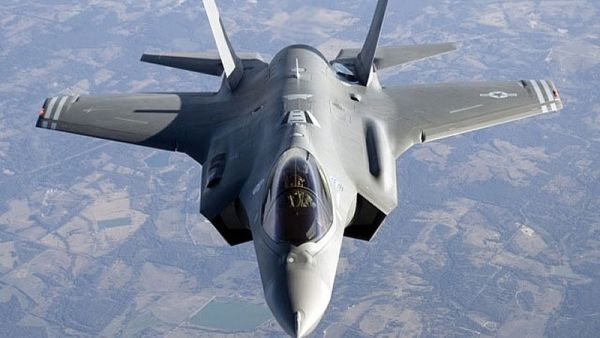By Ty Joplin
Turkey’s purchase of Russia-made S-400 missile defense systems is news that has been relegated to military outlets with the occasional mention by a major media publication.
But the missile system’s acquisition by Turkey has broad and wide-ranging implications for the political landscape of the Middle East. An immediate consequence has been the U.S.’ refusal to deliver 100 F-35 jets to Turkey, which would serve as the basis of a modernized Turkish Air Force.
Now, other major arms deals between Turkey and the U.S. are likely to be threatened.
The purchase is a sign Turkey is courting a major realignment away from NATO and towards Russia.
The ongoing economic spats between Turkey and the U.S. is only accelerating that shift. That the S-400 purchase is continuing in spite U.S. threats means Turkey is serious about its burgeoning partnership with Vladimir Putin’s Russia.
Though there are reasons to doubt the partnership’s longevity, it could redraw the geopolitical fault lines of the Middle East, or at least solidify a shift that has been slowly underway.
The realignment can roughly be thought of as a series of dominos hitting each other: the first domino Turkey flicked was its purchase of the S-400 system. Now, that domino is hitting the second in the line, the f-35 jet deal, and it is falling. As it falls, it causes a chain reaction that, if not stopped, may collapse Turkey’s relationship with the U.S. and NATO entirely.
A Russia-Turkey-Iran bloc is forming as a counter to the traditional NATO bloc in the region.
The First Domino: Turkey’s Purchase of a Russian Missile Defense System
The S-400 missile defense system (AFP/FILE)
After courting China to deliver a missile defense system, Turkey eventually landed on Russia’s S-400, which is an anti-aircraft weapon system developed by Russia that’s been used since 2007.
Despite warnings from the U.S., Turkey and Russia signed a deal to finalize the $2.5 billion purchase of the S-400 system in Dec 2017. What makes the S-400 stand out as a troublesome acquisition by Turkey is the fact that it is non-interoperable with NATO’s own missile defense infrastructure.
This means the S-400 cannot be integrated into NATO’s defense grid. Turkey’s purchase of the system makes it the first NATO country to buy the technology.
In retaliation of the deal and amidst heightened tensions between Turkey’s Erdogan and Trump, U.S. lawmakers stopped the purchase and delivery of 100 F-35 fighter jets to Turkey in Aug 2018.
The halt not only prevents Turkey from getting the coveted F-35 jet to modernize its own air fleet, but it also cuts Turkey out of co-hosting the F-35 Joint Strike Fighter Program under NATO, which is set to become the future central piece in NATO countries’ respective air forces.
That has yet to stop Turkey from going through on the deal for the S-400: Turkish Defence Minister Hulusi Akar announced in Oct 2018 that the Russian-made system will be deployed in Oct 2019. On top of that, the Turkish officials in charge of implementing the system announced that it will be staffed by Turkish personnel and it will have its own target identification system produced domestically.
In practical terms, that means Turkey’s S-400 system will have a remarkable amount of autonomy and may act independently of NATO guidelines.
Akar also said in his Oct 2018 press conference that Turkey briefly looked into purchasing the Patriot missile defense system co-produced by U.S.-based manufacturers, but the talks “have not yielded desired results.”
As the Oct 2019 deadline approaches, neither side appear to be budging in the standoff.
“The current deal is a done deal,” Turkey’s foreign minister Mevlut Cavusoglu said, “I cannot cancel it.”
The Rest of the Dominos: What the S-400 Purchase Actually Indicates
Putin and Erdogan (AFP/FILE)
These moves are mostly happening in small bureaucratic steps and technocratic statements covered by niche outlets. But these purchases and order cancellations indicate an ever-widening chasm between NATO, led by the U.S., and Turkey that could have far-reaching geopolitical consequences, especially for the Middle East.
Since Turkey and Russia began normalizing diplomatic relations in June 2016, they have become fast friends.
The site of their greatest cooperation has been Syria, where they have both become important dealmakers and have overseen cooperative efforts to steer the direction of the conflict.
When Turkey began plans to invade and occupy the Kurdish-held Afrin region of Syria in the country’s northwest, it coordinated with Russia to make sure it could access Syrian airspace. In exchange for access to airspace, Russia convinced Turkey to order Syrian rebels to withdraw from the strategic Abu Duhur airport in Idlib.
The trade gave Turkey the ability to take Afrin, while giving Russia and the Syrian regime an advantageous position to mount an offensive against the rebel-held Idlib region.
Later, when the Syrian regime mobilized for an all-out offensive against Idlib, Turkey and Russia led the way to negotiate a demilitarization deal to stave off the operation.
Compare this cooperative relationship between Russia and Turkey with the U.S. and Turkey in Syria. The U.S. and Turkey’s local aims for Syria are diametrically opposed: the U.S. has sought to bolster Kurdish militia’s hold on northeastern Syria, while Turkey considers those same groups to be terrorists.
Turkey has threatened to attack the U.S./Kurdish-held region, while Trump has threatened to ‘devastate’ Turkey with sanctions if they do indeed attack. These two NATO member states regularly bash one another and threaten armed conflict as a matter of course.
Moreover, Trump started a trade and sanctions war against Erdogan's Turkey over the latter’s detention of U.S. pastor Andrew Brunson. Trump hiked up duties on steel and aluminum imports, while Erdogan threatened to boycott U.S. electronics a few days later.
All indications point to a burgeoning Russian-Turkish strategic alliance at the expense of the U.S. and NATO, even if it is just a marriage of convenience.
There are, however, two reasons to doubt the longevity of such a partnership.
A U.S.-manufactured, Turkish operated F-16 (AFP/FILE)
First, Turkey's’ armed forces are still heavily dependent on E.U. and U.S. arms and vehicle manufacturers: nearly all of its military equipment and vehicles are supplied from the West. If enough NATO countries threaten to bar Turkey’s ability to purchase its arms and vehicles from them, Turkey will be left with an ultimatum: acquiesce to the NATO countries’ demands and disavow its alliance with Russia, or abandon NATO in favor of Russia.
The latter would eventually require Turkey to re-equip its military with non-NATO-state-made products, which would be astronomically expensive and essentially unfeasible in the short-to-medium term. Its airforce relies on Lockheed Martin-made F-16s, planes developed by the European manufacturer Airbus along with other assets made by Boeing.
Even its own Turkish tech companies like Turkish Aerospace Industries (TAI) relies on partnerships with U.S. companies like Northrop Grumman, Boeing and Sikorsky. These partnerships may be threatened, which in turn hurt the capacities of TAI to develop Turkish air tech, like UAVs.
Its land forces also rely on U.S.-made M60 Patton tanks along with other U.S.-manufactured armored vehicles and heavily artillery.
Since the deal for the S-400, the U.S. is already threatening this ultimatum.
A recent, unclassified Pentagon report hinted that the U.S. could “trigger U.S. sanctions and could affect Turkey’s acquisition of other weapons including Boeing Co.’s CH-47F Chinook helicopter and Lockheed’s F-16 fighter and UH-60 Black Hawk helicopters.” This threat, if followed through with, would force Turkey to completely re-tool its miltiary away from U.S.-based manufacturers to avoid obsolescence.
The costs of the partnership would quickly add up to more than it is worth.
The second reason to doubt the longevity of the partnership is that domestic troubles inside Russia may hamper Putin’s ability to be a regional dealmaker at all. The Russian economy has been in shambles for a decade, and Putin was forced to raise the retirement age by five years to give financial breathing room for a government slowly going broke. As a result, Putin’s favorability rating has fallen to a 13-year low.
Meanwhile, Russians are divided as to whether Russia’s indefinite involvement in Syria has done more harm than good. To assuage these concerns, Putin publicly announced Russia’s withdrawal from Syria in Dec 2017, but failed to mention the acquisition of two semi-permanent military bases in the country.
Russia’s role in Syria has only grown since then, but its state finances may force a retreat from the country as part of a larger retrenchment from the Middle East.
Turkey then, would likely be abandoned.
The Last Domino: Turkey’s Exit from NATO
Erdogan (AFP/FILE)
Turkey’s expulsion or departure from NATO has been an unthinkable question. NATO and U.S. officials have been adamant in expressing Turkey’s strategic importance as an ally, but have been slowly shifting their rhetoric.
In 2017, when the S-400 controversy began, Gen. Petr Pavel, chairman of NATO’s Military Committee told reporters, “No one challenges the role of Turkey as an important ally at the very difficult crossroads of challenges to the alliance,”
By contrast, U.S. officials in 2018 appeared unperturbed by Turkey’s strategic importance in excluding them from the F-35 deal and, by extension, the new standard in NATO jet technology.
“While it will have some impact on the F-35 program, I don’t think it’s going to be any type of devastating impact if … there’s a policy decision that they are no longer a partner,” Heidi Grant, the Air Force’s deputy undersecretary for international affairs said in Dec 2018.
It is still far, far too early to seriously consider the implications of Turkey leaving NATO or speculate about its likelihood, but it is likely a question being asked by policymakers in Washington D.C. and Istanbul.
If the S-400 delivery does indeed go through and Turkey begins relying on a defense system that is non-interoperable with NATO’s own, the question of NATO slowly excluding Turkey from intelligence sharing, weapons deals and other military partnerships will arise. Evidence, like the looming exclusion from the F-35 program, shows it already has.
From there, NATO members will accelerate their relocation of military bases from Turkey to other regional countries. This process has begun while tensions between Turkey and other NATO countries rise. Germany relocated its military assets from the the Incirlik Airbase in Turkey to the Azraq Air Base in Jordan. The U.S. too is looking to expand its military presence in Greece, Jordan and Qatar; away from Turkey.
The S-400 system may have just been the beginning of a long, multifaceted Turkish realignment. And as it warms to Russia, the entire political landscape of the Middle East changes with it.







